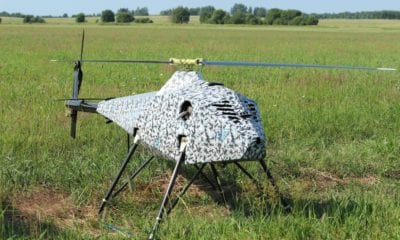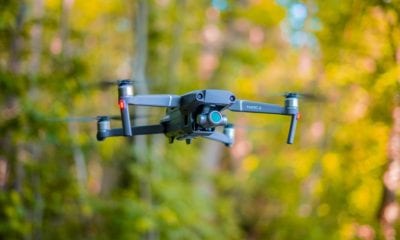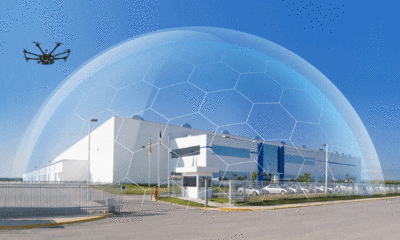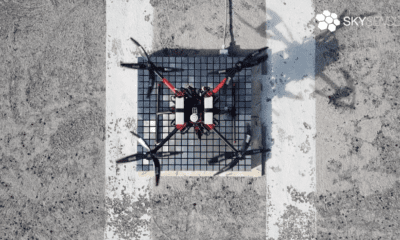Industry
Novel Use of Drones and LIDAR for the Early-Detection of Plant Diseases
Currently, drones are capable of more than just flying – and this is being proven day after day with new studies and papers that highlight the importance of these unmanned aircraft systems (UAS).
One of the aspects in which drones are found to thrive is their ability to autonomously carry out an increasing number of duties with substantially greater efficiency compared to human intervention. Currently, the UAS researchers aim to enhance the levels of safety, ramp up the mission effectiveness and autonomy as well as explore additional capabilities.
Crop Health Monitoring and UAS-Borne EO/IR Systems Based on LiDAR
Crop health monitoring is a promising application of UAS as the early detection of plant diseases can supplement traditional crop monitoring techniques (such as visual observation) in order to support timely mitigation.
A new paper published by a group of authors presents new UAS-borne Electro-Optics/Infrared (EO/IR) systems based on bistatic Light Detection and Ranging (LiDAR) systems for early detection of crop diseases. The bistatic LiDAR system measures over extended observation periods above the crop canopy anomalies in carbon dioxide concentration – linked to disruptions in the plant photosynthesis.
While the introduction begins addressing the various plant diseases which cause a remarkable yield loss and quality degradation, the authors later on state various ways in which crops can be protected (from the diseases, weeds and pests) and reduce the costs and the risk of toxic residues in the products.

Overview of the bistatic LIDAR system concept and parasite irradiance contributions (including background).

UAS system diagram
Remote Sensing Technologies: Detecting and Evaluating Crop Stress
One of the ways are remote sensing technologies which have therefore been developed to characterize the spatial and temporal evolution of diseases, weeds and pests over wide areas.
The authors state the following:
“Remote sensing is advantageous to conventional manual assessment techniques as it does not require physical proximity to the individual plants [1]. Modifications in pigment, nutrient, gas exchange, water uptake, cell structure and chemical concentrations are affected by the presence of diseases and thus can potentially be exploited for remote sensing.”
The current remote sensing technologies can detect and evaluate the crop stress from variations in the spectral and shape characteristics of canopy, mostly influenced by biotic and abiotic stress agents.
The aim of their research, on the other hand, is to develop UAS-borne remote sensing techniques for early detection of crop diseases and support the sensor design and integration on a suitable UAS. To support the sensor design and integration on a suitable UAS, different numerical and experimental activities are planned under controlled conditions – all to identify the most suitable combination of sensors and systems for specific diseases.
Strawberry Powdery Mildew
The literature available out there focuses on early detection of plant diseases as well as Multispectral and Hyperspectral Imaging (MSI/HSI) techniques due to their technological maturity. However, the authors note that there is a significant number of major diseases that cannot be detected at early stages mostly due to the similarities of spectral signatures.

Proposed strawberry field monitoring pattern
One of them is powdery mildew (PM), common on crops in Australia and with a potential to be detected by MSI/HSI, causing significant yield damage or extensive spraying of fungicides.
The LIDAR system that the authors use is explained as “a very viable method to remotely sense atmospheric constituents because the characteristics of the laser beam at the receiver can provide information on the medium through which the laser passed.”
As the authors further explain, “The Differential Absorption LIDAR (DIAL) measurement principle, extensively used for remote sensing, exploits the wavelength-selective absorption properties of molecular species”
On top of the research, the authors also carried an ‘uncertainty analysis’ in order to determine the effect of various design parameters which dictate the maximum achievable resolution of the system.
Conclusion
In the paper, we can see the initial design and error budgeting activities carried out in relation to a novel bistatic LIDAR system for early plant disease detection. As showed, the bistatic LIDAR system enables the detection of anomalies in the gaseous concentrations around the plans, symptomatic of the presence of a disease.
However, further work is needed in order to address the experimental characterization and calibration of the system in the lab and the custom-built chamber, as well as the ground and flight tests in strawberry fields.
Citation: “A Novel Bistatic LIDAR System for Early-Detection of Plant Diseases from Unmanned Aircraft”. Pham, Hai & Lim, Yixiang & Gardi, Alessandro & Sabatini, Roberto. (2018). https://www.researchgate.net/publication/328912761_A_Novel_Bistatic_LIDAR_System_for_Early-Detection_of_Plant_Diseases_from_Unmanned_Aircraft
























